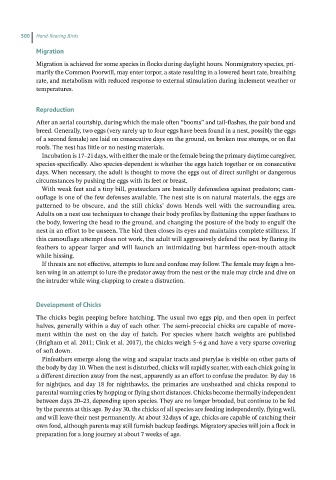Page 503 - Hand rearing birds second
P. 503
500 Hand-Rearing Birds
Migration
Migration is achieved for some species in flocks during daylight hours. Nonmigratory species, pri-
marily the Common Poorwill, may enter torpor, a state resulting in a lowered heart rate, breathing
rate, and metabolism with reduced response to external stimulation during inclement weather or
temperatures.
Reproduction
After an aerial courtship, during which the male often “booms” and tail‐flashes, the pair bond and
breed. Generally, two eggs (very rarely up to four eggs have been found in a nest, possibly the eggs
of a second female) are laid on consecutive days on the ground, on broken tree stumps, or on flat
roofs. The nest has little or no nesting materials.
Incubation is 17–21 days, with either the male or the female being the primary daytime caregiver,
species‐specifically. Also species‐dependent is whether the eggs hatch together or on consecutive
days. When necessary, the adult is thought to move the eggs out of direct sunlight or dangerous
circumstances by pushing the eggs with its feet or breast.
With weak feet and a tiny bill, goatsuckers are basically defenseless against predators; cam-
ouflage is one of the few defenses available. The nest site is on natural materials, the eggs are
patterned to be obscure, and the still chicks’ down blends well with the surrounding area.
Adults on a nest use techniques to change their body profiles by flattening the upper feathers to
the body, lowering the head to the ground, and changing the posture of the body to engulf the
nest in an effort to be unseen. The bird then closes its eyes and maintains complete stillness. If
this camouflage attempt does not work, the adult will aggressively defend the nest by flaring its
feathers to appear larger and will launch an intimidating but harmless open‐mouth attack
while hissing.
If threats are not effective, attempts to lure and confuse may follow. The female may feign a bro-
ken wing in an attempt to lure the predator away from the nest or the male may circle and dive on
the intruder while wing‐clapping to create a distraction.
Development of Chicks
The chicks begin peeping before hatching. The usual two eggs pip, and then open in perfect
halves, generally within a day of each other. The semi‐precocial chicks are capable of move -
ment within the nest on the day of hatch. For species where hatch weights are published
(Brigham et al. 2011; Cink et al. 2017), the chicks weigh 5–6 g and have a very sparse covering
of soft down.
Pinfeathers emerge along the wing and scapular tracts and pterylae is visible on other parts of
the body by day 10. When the nest is disturbed, chicks will rapidly scatter, with each chick going in
a different direction away from the nest, apparently as an effort to confuse the predator. By day 16
for nightjars, and day 18 for nighthawks, the primaries are unsheathed and chicks respond to
parental warning cries by hopping or flying short distances. Chicks become thermally independent
between days 20–23, depending upon species. They are no longer brooded, but continue to be fed
by the parents at this age. By day 30, the chicks of all species are feeding independently, flying well,
and will leave their nest permanently. At about 32 days of age, chicks are capable of catching their
own food, although parents may still furnish backup feedings. Migratory species will join a flock in
preparation for a long journey at about 7 weeks of age.

